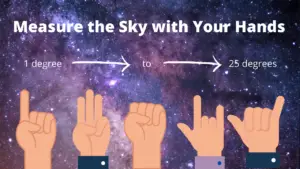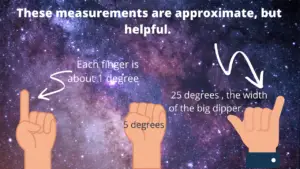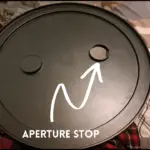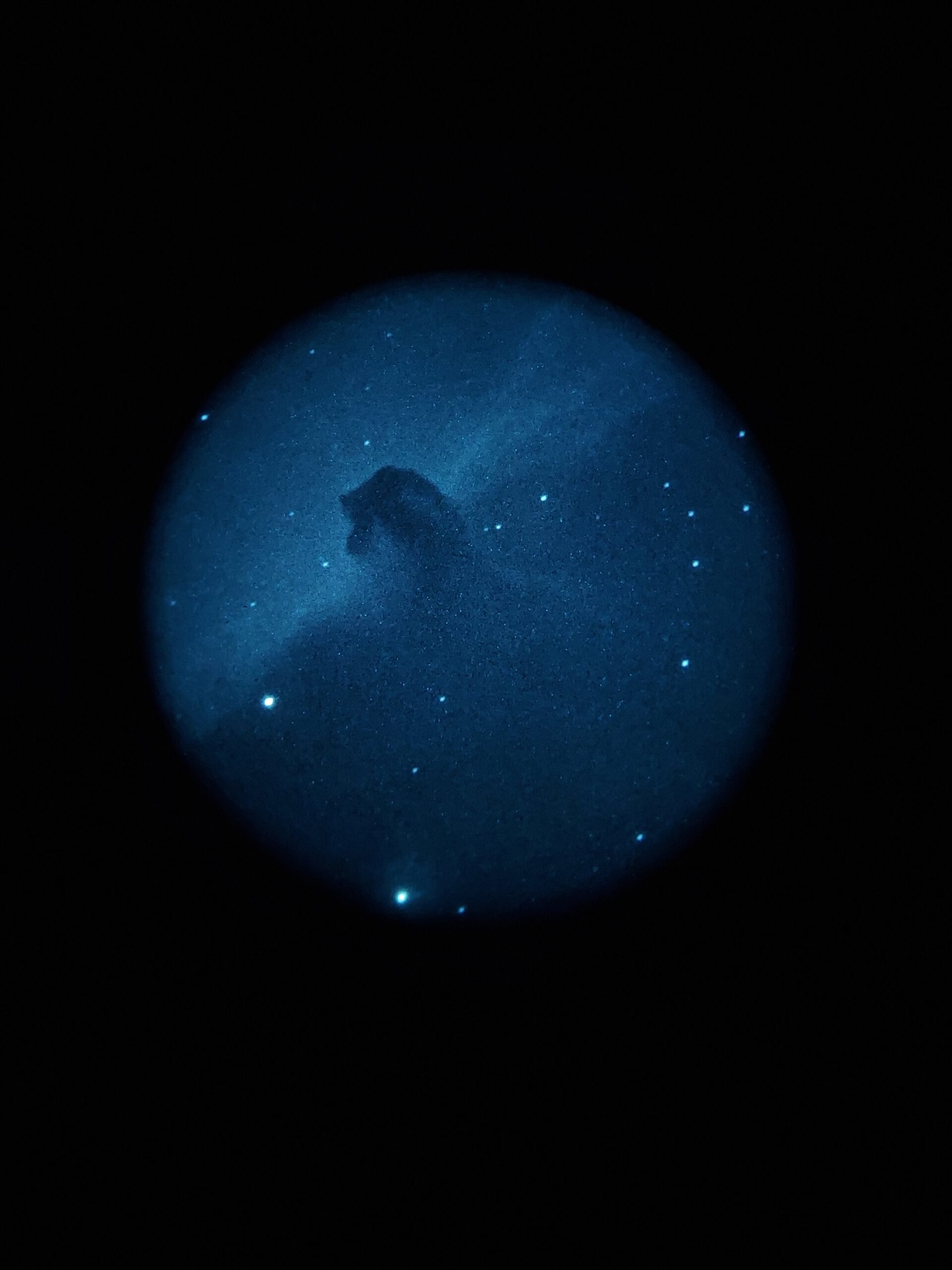If you’ve spent any time reading about astronomy, you’ve probably come across some peculiar units of measure: degrees, arc-minutes, and arc-seconds. They might seem confusing at first, but they are not difficult to use once you understand how they work.
Arc-minutes, arc-seconds, and degrees of arc are used to describe angular separation, or apparent size.
To see what this means, you might compare a distant skyscraper with a nearby lamppost. Intuitively, you know that the skyscraper is many times larger than the lamppost. But according to the two-dimensional image formed on your retina, they are nearly the same angular size. Your brain uses a combination of visual cues and experience to determine the actual size of objects in your environment and create three-dimensional perception.
When it comes to the night sky, such visual cues are absent. It would be impossible to say, by vision alone, whether the sun or the moon is closer to Earth.
Judging only by appearance, one could conclude that they are the same size as each other, situated equal distances from our planet.
Degrees of Arc
In fact, you are probably more familiar with these units than you realize. If you’ve ever heard of a snowboarder doing a three-sixty on the slope, or a politician doing a one-eighty on his position, these figures are in degrees of arc. Likewise, any time you refer to the grade of a slope, this also corresponds to degrees of arc. Considering that a point directly in front of a you and a point directly overhead are separated by 90 degrees of arc (i.e., planes at right angles), a plane halfway between horizontal and vertical is a 45-degree slope, separated from both the horizontal and vertical planes by 45 degrees of arc.
But what about this business of minutes and seconds?
It seems rather odd to deal with distance using units of time, after all. Don’t get thrown off by these terms.
It is enough to know that if you rotate in a full circle, that rotation can be divided into 360 sections called degrees of arc. Each degree can then be broken into 60 smaller sections called arc-minutes (denoted by the symbol ‘), and each arc-minute can also be broken into 60 sections called arc-seconds (denoted by “).
What does any of this have to do with astronomy?
Remember that we lack depth perception when observing the night sky. Since we can’t perceive any true depth in the night sky, it is useful to imagine that we, the observer, are surrounded by an immense sphere to which all the stars, planets, and other celestial bodies are fixed.
This concept is called the celestial sphere and is indeed how ancient people envisioned the heavens. Of course, we now know that no such sphere exists, but the idea is still extremely useful, as it allows us to devise a celestial coordinate system (which we’ll discuss in a future article) and to describe the apparent size of, and separation between, celestial objects.
These units are only useful to the amateur if there is an easy way to estimate them. Luckily, there is a tried-and-true method of approximating angular separation using nothing more than your bare hand.
Holding your hand at arm’s length, the width of your little finger will cover about one degree of the sky, or twice the diameter of the full moon. Your three middle fingers cover about five degrees; a closed fist, about ten degrees; making the surfer sign with your thumb and little finger will span about twenty-five degrees, the width of the Big Dipper.


Naturally, these figures are approximate and can vary a fair amount depending on the size of your hand. Nevertheless, these hand signs can help you navigate the sky, giving some context to the otherwise mysterious degrees.
What are Arc-Minutes and Arc-Seconds?
Now we know how to handle degrees of arc. But what about those minutes and seconds? These units are too small to measure with our extended hands; we need some other benchmark.
The full moon is helpful in this regard, covering about 30 arc-minutes, or half of one degree. The Andromeda Galaxy, M31, extends about six times that amount at 3 degrees in length, but most deep-sky objects are much smaller.
According to Wikipedia, the human eye has an angular resolution of 1 arc-minute, meaning that we should theoretically be capable of seeing a great many clusters and nebulae without optical aid, but the faintness of these objects means we require binoculars or a telescope to view them, increasing not only their angular size but also their brightness.


Armed with this knowledge, we can get a sense of scale for various objects. M13, the Hercules Cluster, has a diameter of around 20 arc-minutes, about two-thirds of the moon’s angular diameter. For M57, the Ring Nebula, the diameter is just over one arc-minute.
We can then deduce that it will require 20x magnification with a telescope to make M57 the same apparent size as M13, and 30x to make it moon-sized. The apparent size of Jupiter varies between 6x (50”) and 10x (30”) smaller than the moon, while Mars varies by a large amount, only 3.5” at its furthest from Earth, and ballooning to 25” during close approaches.
Arc-Seconds
We don’t really need to worry about arc-seconds until it comes to observations near the resolution limit of our telescopes.
If you check your telescope’s specification sheet, it should give a figure called resolving power, measured in arc-seconds. This describes the theoretical maximum resolution of your optics, assuming they are perfectly configured, aligned, and under perfect viewing conditions, actual resolution will always be somewhat less.
An 8-inch Newtonian reflector has a resolving power of 0.57”; for a 12-inch reflector, this improves to 0.38”. Greater resolving power means more detailed views; it is important when observing very fine planetary detail or splitting close binary stars.
How to Use Arc-seconds and Arc-minutes
These units also come in handy when shopping for equipment such as eyepieces.
While different eyepieces will provide different magnifications with a given telescope, they will also provide different fields of view. Likewise with camera/telescope combinations.
If you want to view or shoot the full moon, you must use equipment which provides a field of view greater than 30 arc-minutes. For the Pleiades cluster, this figure is over 100 arc-minutes. To capture the entire Andromeda Galaxy, you need a field of view at least 180 arc-minutes wide.
Next time you go out stargazing, test this new knowledge:
Use your extended hand to estimate the separation between two bright stars, or the size of a constellation.
Try to gauge the size of various objects within that view. (Take into account your telescope’s field of view)
This sort of practice will make your observations keener and might even improve your ability to map out the heavens.






